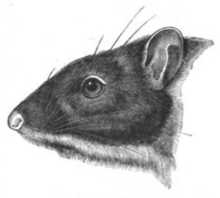Megalomys desmarestii
| Megalomys desmarestii | |
|---|---|

| |
| Stuffed specimen | |
| Scientific classification | |
| Domain: | Eukaryota |
| Kingdom: | Animalia |
| Phylum: | Chordata |
| Class: | Mammalia |
| Order: | Rodentia |
| Family: | Cricetidae |
| Subfamily: | Sigmodontinae |
| Genus: | †Megalomys |
| Species: | †M. desmarestii
|
| Binomial name | |
| †Megalomys desmarestii (J. Fischer, 1829)
| |
Megalomys desmarestii, also known as the Martinique muskrat,rice rat from Martinique in the Caribbean.
Description
It was among the largest species of
West Indian rice rats, as big as a cat, and was one of the first Caribbean mammals to become extinct during the 20th century.[2] It may have been semi-aquatic, as it was known to escape into the sea when pursued by predators, but it never swam away from the island.[4]

Extinction
It was common on Martinique until the end of the 19th century, when attempts were made to exterminate it because it was considered to be a pest of the island's coconut plantations. It was also hunted for food; however, due to its strong musky odor, this was uncommon. On 8 May 1902, the volcano Mount Pelée erupted, completely destroying the island's principal city of Saint-Pierre. It has been speculated that the rice rat became extinct then or during a later eruption in 1902, but predation by introduced small Indian mongooses is more likely to have been the primary cause of its extinction.[1]
References
- ^ . Retrieved 18 November 2021.
- ^ ISBN 0-521-38651-9
- ISBN 978-0-8018-8221-0
- ISBN 0-87113-797-6

